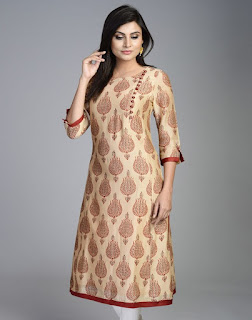When
shopping gives you an enthusiastic feel then why cant you learn how
those cheerful garments are made? If you are buying a product, try to
analyze some basic things about it, so that you can have a broad mind
and a smart shopping. When you have something unique to wear, why to go
for a regular one? Learn about some traditional designs and how they are
made. How does it look on your body? What difference it makes?
1 Block Printing
It is one of the oldest direct printing techniques. A design is carved into some hard substance like wood. Designed wood is dipped in dye and pressed on fabric. You can make your own designs by getting those wooden blocks and dye's from market. It is clear that block printed clothes are followed by same design which will be repeated on clothes.
Get it from: Oklipuram, Commercial street & Chickpet in bangalore.
Get it from: Oklipuram, Commercial street & Chickpet in bangalore.
2 Screen Printing

Source: Internet

A similar way of block printing, in which four sides are covered with wooden frames and in the middle the designs have been drawn. Place the frame on cloth and then pour the dye color on it. To make it spread, move the frame back and forth. It coats the color on fabric through the pores in thin screen attached to the frame. Different screens must be used for different color.
3 Kalamkari

Source : Internet

Kalamkari is been fabricated in Machilipatnam and kalahasthi of Andhra Pradesh. The word "kalam" refers to bamboo sticks. It is sharpened for drawing thin lines and precise designs. Once the process of printing & drawing is done the fabric is washed in a running water. After washing it is boiled in water and then it is dipped inside the vessels. Post this process the fabric has to be soaked in cow milk for 5-6 hours and then dried under sun. This method uses natural dyes extracted from root of plant, color red from madder root of plant, yellow from flowers (or) pomegranate seeds or even mango bark. Black color is extracted from mybrobalam fruit. Even some chemicals also added now-a-days to make the colors vivid.
Kalamkari would suit you best when it's worn as a saree or blouse with plain saree.
4 Ikat
| Source:Internet |
Ikat is also a traditional fabrication method which is processed in Gujarat. Here the thread is colored by tie & dye technique and then placed in a specific pattern as horizontal & vertical (technically called as warp & weft) and then weaved accordingly. You can now buy different products of Ikat designs on "Amazon" and sarees in Bangalore market. It suits trendy women's above the age of 40. We would recommend to try with some mild printed blouse.
Source: Internet
Gujarat and Rajasthan is native to Bandhani & it is one of the most recognizable Indian prints. Its is similar to tie & dye technique which differs only by their design techniques like dots, stripes, waves& squares. We are mostly familiar with these designs on sarees. Due to its vibrant colors and simple designs it fails to make first impression. But it looks classy when you try out different styles of wearing Bandhani. It's all about selecting the style which would suit you the best.
Source: Internet
Let us know about something interesting and easy to make. Yes, Batik is a very simple and beautiful art of making designs on fabrics with the help of wax. This method starts with creating a template with plastic or wooden of your design. By placing the template over the fabric apply molten wax in your fabric, so that apart from your design the entire fabric should be waxed. Batik carries very simple designs because its really tough to make perfect one. After making designs on fabric dip it into the boiling water which helps you removing the wax on it. Try at home on plain cotton shirts for women, stoles and plain dull fabrics with your favorite dye color.











0 Comments